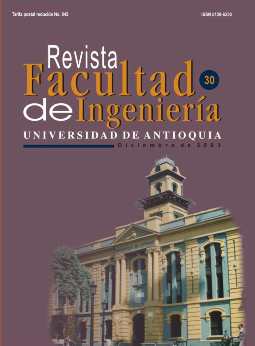Measurement of electrode potential in oil in water emulsions
DOI:
https://doi.org/10.17533/udea.redin.327315Keywords:
oil in water emulsion, polarization curves, reference electrodes, cell geometryAbstract
This study was performed taking into account the problems found when common reference electrode systems like SCE with a satured KCl bridge are used. Tests were carried out to establish the most appropriate reference electrodes for measurement of electrode potentials in emulsions kerosene in water. Four reference cells were tested, looking for compatibility between aqueous and oil phases inherent to the nature of these emulsion systems. The cell SCE/Sat KCl/Agar 3% + 0,1 M KCl// was taken as reference cell. The corrosion systems studied were aqueous solution of satured KCl, aqueous solution containing 1.000 ppm of anionic surfactant (GR-7M) and kerosene in water emulsions with 5, 20, 40 and 60 weight per cent. The cell //AgarGR7M (1%)/GR7M (1%)/SCE was chosen due to its long stability with time and small joining potentials.
Downloads
References
Sawyer, D. T. y J. L. Roberts. Experimental Electrochemistry for Chemists. New York. John Wiley & Sons. 1987.
Ives, D. y G. Janz. Reference Electrodes: Theory and Practice. New York. Academic Press. 1969.
Watson, S. W. y B. W. Madsen. “Aplicability of reference electrode types in transient electrochemical experiments”. En: Corrosión (NACE). Vol. 48. No. 9. 1992. DOI: https://doi.org/10.5006/1.3315993
Jasinski, R. J. y R. D. Efird. “Electrochemical corrosion measurements in crude oil”. En: Corrosión (NACE). Vol. 43. No. 8. 1987. p. 476. DOI: https://doi.org/10.5006/1.3583888
Coetzee, J. F. and C. W. Gardner. “Teflon double-junction reference electrode for use in organic solvents”. En: Analytical Chemistry. Vol. 54. No. 14. 1982. p. 2.625. DOI: https://doi.org/10.1021/ac00251a058
Retamoso, C. et al. Procesos electroquímicos en emulsiones. Proyecto UIS-ICP, 1993.
Becher, P. “Dielectric properties of emulsions and related systems”. En: Enciclopedia de las emulsiones. 1987.
Peña, D. Comportamiento electroquímico de un acero AISI 1020 en emulsiones blancas inversas. Tesis de Maes-tría. Universidad Industrial de Santander. s. E. 1994.
Echeverría, F. Determinación de velocidades de corro-sión en sistemas emulsionados aceite en agua. Tesis de Maestría. Universidad Industrial de Santander. 1995.
Izutsu, K. et al. “Experimental studies of the liquid junction potential between electrolyte solutions in diferent solvents. I. Water-Organic solvent junctions”. En: Bulletin of the Chemical Society of Japan. Vol. 51. No. 3. 1978. p. 783. DOI: https://doi.org/10.1246/bcsj.51.783
Diggle, J. W. y A. J. Parker. “Liquid junction potencials in electrochemical cells involving a dissimilar solvent junction”. En: Australian Journal of Chemistry. Vol. 27. 1974. p. 1.617. DOI: https://doi.org/10.1071/CH9741617
Adams, R. N. Electrochemistry at solid electrodes. New York. Marcel Denker Inc. 1969.
Downloads
Published
How to Cite
Issue
Section
License
Revista Facultad de Ingeniería, Universidad de Antioquia is licensed under the Creative Commons Attribution BY-NC-SA 4.0 license. https://creativecommons.org/licenses/by-nc-sa/4.0/deed.en
You are free to:
Share — copy and redistribute the material in any medium or format
Adapt — remix, transform, and build upon the material
Under the following terms:
Attribution — You must give appropriate credit, provide a link to the license, and indicate if changes were made. You may do so in any reasonable manner, but not in any way that suggests the licensor endorses you or your use.
NonCommercial — You may not use the material for commercial purposes.
ShareAlike — If you remix, transform, or build upon the material, you must distribute your contributions under the same license as the original.
The material published in the journal can be distributed, copied and exhibited by third parties if the respective credits are given to the journal. No commercial benefit can be obtained and derivative works must be under the same license terms as the original work.










 Twitter
Twitter